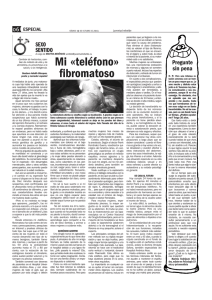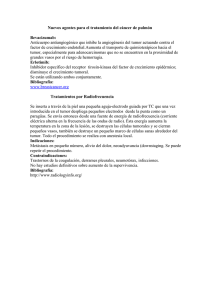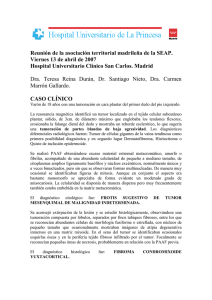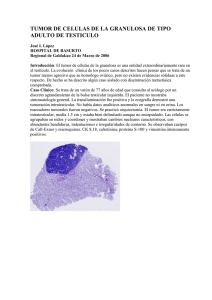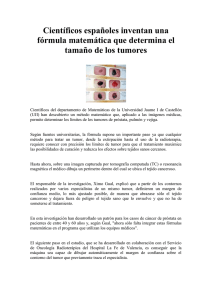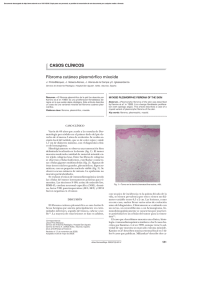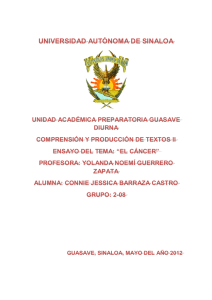Fibroma ameloblástico mandibular. Presentación de dos casos
Anuncio
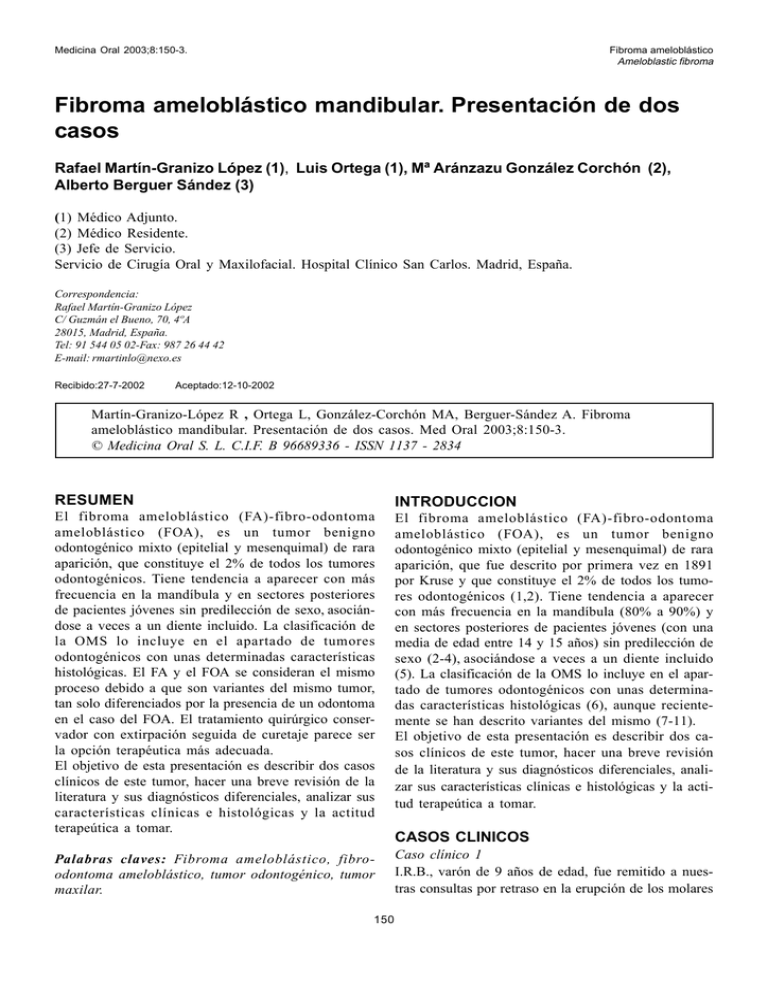
Medicina Oral 2003;8:150-3. Fibroma ameloblástico Ameloblastic fibroma Fibroma ameloblástico mandibular. Presentación de dos casos Rafael Martín-Granizo López (1), Luis Ortega (1), Mª Aránzazu González Corchón (2), Alberto Berguer Sández (3) (1) Médico Adjunto. (2) Médico Residente. (3) Jefe de Servicio. Servicio de Cirugía Oral y Maxilofacial. Hospital Clínico San Carlos. Madrid, España. Correspondencia: Rafael Martín-Granizo López C/ Guzmán el Bueno, 70, 4ºA 28015, Madrid, España. Tel: 91 544 05 02-Fax: 987 26 44 42 E-mail: [email protected] Recibido:27-7-2002 Aceptado:12-10-2002 Martín-Granizo-López R , Ortega L, González-Corchón MA, Berguer-Sández A. Fibroma ameloblástico mandibular. Presentación de dos casos. Med Oral 2003;8:150-3. © Medicina Oral S. L. C.I.F. B 96689336 - ISSN 1137 - 2834 RESUMEN INTRODUCCION El fibroma ameloblástico (FA)-fibro-odontoma ameloblástico (FOA), es un tumor benigno odontogénico mixto (epitelial y mesenquimal) de rara aparición, que constituye el 2% de todos los tumores odontogénicos. Tiene tendencia a aparecer con más frecuencia en la mandíbula y en sectores posteriores de pacientes jóvenes sin predilección de sexo, asociándose a veces a un diente incluido. La clasificación de la OMS lo incluye en el apartado de tumores odontogénicos con unas determinadas características histológicas. El FA y el FOA se consideran el mismo proceso debido a que son variantes del mismo tumor, tan solo diferenciados por la presencia de un odontoma en el caso del FOA. El tratamiento quirúrgico conservador con extirpación seguida de curetaje parece ser la opción terapéutica más adecuada. El objetivo de esta presentación es describir dos casos clínicos de este tumor, hacer una breve revisión de la literatura y sus diagnósticos diferenciales, analizar sus características clínicas e histológicas y la actitud terapeútica a tomar. El fibroma ameloblástico (FA)-fibro-odontoma ameloblástico (FOA), es un tumor benigno odontogénico mixto (epitelial y mesenquimal) de rara aparición, que fue descrito por primera vez en 1891 por Kruse y que constituye el 2% de todos los tumores odontogénicos (1,2). Tiene tendencia a aparecer con más frecuencia en la mandíbula (80% a 90%) y en sectores posteriores de pacientes jóvenes (con una media de edad entre 14 y 15 años) sin predilección de sexo (2-4), asociándose a veces a un diente incluido (5). La clasificación de la OMS lo incluye en el apartado de tumores odontogénicos con unas determinadas características histológicas (6), aunque recientemente se han descrito variantes del mismo (7-11). El objetivo de esta presentación es describir dos casos clínicos de este tumor, hacer una breve revisión de la literatura y sus diagnósticos diferenciales, analizar sus características clínicas e histológicas y la actitud terapeútica a tomar. Palabras claves: Fibroma ameloblástico, fibroodontoma ameloblástico, tumor odontogénico, tumor maxilar. Caso clínico 1 I.R.B., varón de 9 años de edad, fue remitido a nuestras consultas por retraso en la erupción de los molares 150 CASOS CLINICOS Medicina Oral 2003;8:150-3. Fibroma ameloblástico Ameloblastic fibroma inferiores definitivos. La radiografía panorámica mostraba una gran lesión radiopaca en la región molar izquierda de la mandíbula que impedía la erupción del primer molar (Fig. 1). Bajo anestesia general se realizó extirpación de la lesión por vía intraoral, preservando el primer molar definitivo y sin dañar el canal del nervio alveolar inferior, que se encontraba rechazado por el tumor; la cavidad no se rellenó con material alguno. Los controles radiográficos postoperatorios mostraron una progresiva erupción del molar definitivo aunque lingualizado debido a sus raíces en gancho, por lo que requirió posterior exodoncia, sin objetivar a los 12 años de evolución (21 años de edad) recidiva del tumor. El análisis histológico mostraba cordones de células de epitelio odontogénico con diferenciación ameloblástica inmersas en un tejido fibroso moderadamente celular junto a focos de depósito cementario y trabéculas óseas, compatible con fibro-odontoma ameloblástico (FOA) (Fig. 2). Caso clínico 2 J.F.C. varón de 8 años de edad visto en consultas de Cirugía Oral y Maxilofacial remitido por su odontopediatra al observar una lesión radiolúcida en una ortopantomografía previa al inicio de la ortodoncia. A la exploración presentaba un leve abombamiento de la cortical ósea en la zona molar mandibular derecha. No refería antecedentes de interés. Se obtuvo una biopsia con anestesia local, que fue informada como FA. Posteriormente, se intervino bajo anestesia general en la Unidad de Cirugía Mayor Ambulatoria (UCMA), realizando una completa extirpación del tumor a través de una incisión mucogingival sin relleno de la cavidad (Fig. 3). La lesión estaba encapsulada y era fácilmente extirpable. El control radiográfico al año de la cirugía no evidenció recurrencia, observándose un apropiado proceso de erupción de los molares definitivos implicados. El análisis histológico reveló cordones de células de epitelio ameloblástico entre una matriz de tejido fibroso moderadamente celular con una típica ausencia de colágeno sin atipias celulares ni mitosis, compatible con FA. DISCUSION El FA y el FOA se consideran el mismo proceso debido a que son variantes del mismo tumor, tan solo diferenciados por la presencia de un odontoma en el caso del FOA (7). Radiológicamente, el FA es una lesión completamente radiolúcida y bien definida (caso 2), mientras que el FOA es radiolúcida con diferentes grados de radiopacidad (caso 1) (6,7,12-15). El diagnóstico diferencial del FA debería realizarse con lesiones como el ameloblastoma, el mixoma odontogénico, quistes dentígeros, queratoquistes odontogénicos, granuloma central de células gigantes e histiocitosis. Además, el FOA debería distinguirse del tumor odontogénico epitelial calcificante (tumor de Pindborg) y del quiste odontogénico calcificante (quiste de Gorlin), de los odontomas, del tumor odontogénico adenomatoide (TOA), del fibroma osificante juvenil y de los fibromas cemento-osificantes (7,13,14). La mayoría de las recidivas se atribuyen a resecciones incompletas (2); así, Zallen y cols. (16), revisaron la literatura médica en 1982 y hallaron 85 casos de FA, de los cuales 14 (el 18,3%) habían recidivado. Además, se han descrito casos de transformación maligna de FA y FOA en fibrosarcoma ameloblástico (un 44% de los fibrosarcomas descritos) (2,17). Por ello, existe controversia en cuanto a la forma de tratamiento, aunque la mayoría de autores recomiendan una resección adecuada seguida de un enérgico curetaje de lecho quirúrgico, tal como realizamos en los dos casos aquí presentados, en lugar de una resección radical en bloque. Recientes estudios analizaron inmunohistoquímicamente el potencial de crecimiento de estos tumores, lo que podría ayudar a tomar una decisión sobre el tipo de resección quirúrgica a realizar (18-20). ENGLISH Ameloblastic fibroma of the mandible. Report of two cases MARTÍN-GRANIZO-LÓPEZ R, ORTEGA L, GONZÁLEZ-CORCHÓN MA, BERGUER-SÁNDEZ A. AMELOBLASTIC FIBROMA OF THE MANDIBLE. REPORT OF TWO CASES. MED ORAL 2003;8:1503. SUMMARY The ameloblastic fibroma (AF)-ameloblastic fibro-odontoma (AFO), is an uncommon benign mixed odontogenic tumor (epithelial and mesenchymal), that represents the 2% of all odontogenic tumors. It usually appears in the mandible and in the posterior segments of young patients without gender predilection, and sometimes is associated with an impacted tooth. The classification of the WHO includes it in the subtype of odontogenic tumors with a defined histologic features. The AF and the AFO are considered as an unique entity as they are variations of the same tumor, only distinct for the presence of an odontoma in the case of the AFO. Surgical conservative 151 Medicina Oral 2003;8:150-3. Fibroma ameloblástico Ameloblastic fibroma treatment with excision followed by curettage seems to be the most appropriate therapeutic option. The objective of this paper is to report two cases of this tumor, to make a brief review of the literature and its differential diagnosis, to analyse its clinical and histologic features and the therapeutic option. Key words: Ameloblastic fibroma, ameloblastic fibroodontoma, odontogenic tumor, maxillary tumor. INTRODUCTION The ameloblastic fibroma (AF)-ameloblastic fibro-1891 by Kruse and represents the 2% of all odontogenic tumors (1,2). It usually appears in the mandible (80% to 90%) and in the posterior segments of young patients (with a medium age between 14 and 15 year-old) without gender predilection (2-4), and sometimes is associated with an impacted tooth (5). The classification of theodontogenic tumors with a defined histologic features (6), although recently several variants have been reported (7-11). The objective of this presentation is to describe two clinical cases of this tumor, to briefly review the related medical literature and the differential diagnosis, to analyse its clinical and histologic features as well as the therapeutic option to be performed. Fig. 2a. Imagen histológica donde se aprecian cordones de células de epitelio odontogénico con diferenciación ameloblástica inmersas en un tejido fibroso moderadamente celular con una zona de esclerosis (superior izquierda) junto a focos de depósito cementario y trabéculas óseas adyacentes (HE x 50). Histologic image where some strands of odontogenic epithelial cells are evidenced with an ameloblastic differentiation within a moderately cellular fibrous tissue with an sclerotic area (superior left) along with foci of cemmentun deposits and neighbour osseous trabecules (HE x 50). CLINICAL CASES Clinical case 1 I.R.B., a 9 year-old male, was referred to our office for a delay in the eruption of his definite inferior molars. The panoramic radiograph showed a big radiopaque lesion over the left molar area of the mandible that difficult the eruption of the first molar (Fig. 1). Under general anaesthesia a resection of the lesion was made through an intraoral approach, protecting the definite first molar and avoiding the inferior alveolar nerve channel, Fig. 1. Ortopantomografía inicial donde se observa una lesión mandibular radiopaca bien delimitada con un halo radiolúcido alrededor, que impide la correcta erupción del primer molar definitivo.El diagnóstico de sospecha fue de odontoma complejo. Initial panoramic radiograph where a mandibular well-rounded radiopaque lesion with a radiolucent halo is observed, and compromises the normal eruption of the first permanent molar. The initial diagnosis was of a complex odontoma. Fig. 2b. Doble hilera de epitelio ameloblástico constituido por células cilíndricas entre un estroma mesenquimal con edema y fibroblastos. No se objetivan atipias celulares ni mitosis (HE x 200). A double row of ameloblastic epithelium formed by cylindrical cells within a mesenchymal stroma with fibroblast and oedema. No cellular atypia nor mitoses were assessed (HE x 200). Fig. 3. Intraoperatory image during the surgical excision through a gingival incision, sparing the follicular sac of the permanent molar. Note the capsule of the tumor. Imagen intraoperatoria durante la extirpación quirúrgica de la lesión a través de una incisión gingival, conservando el saco folicular del molar. Nótese la encapsulación del tumor. 152 Medicina Oral 2003;8:150-3. Fibroma ameloblástico Ameloblastic fibroma that was pushed by the tumor; the resulting cavity was not refilled with any substance. Postoperatory radiographic controls showed a progressive eruption of the definite molar although it was turned toward the lingual area as a result of its hook-like roots, therefore requiring a posterior extraction, without finding recurrence of the tumor in a 12 year follow-up (21 year-old). The histologic analysis evidenced strands of odontogenic epithelial cells with ameloblastic differentiation embedded in a moderately cellular fibrous tissue along with cemmentun foci and osseous trabecules, being diagnosed as an ameloblastic fibro-odontoma (AFO) (Fig. 2). Clinical case 2 J.F.C. a 8 year-old male was seen in the office of the Oral and Maxillofacial Department referred by his infant-dentist for a radiolucent lesion observed in a panoramic radiograph prior to the start of the orthodonthic treatment. On the exploration he showed a slight swelling of the bony cortex over the molar area of the right side mandible. The past medical history was uneventful. A biopsy was obtained under local anaesthesia, that was informed as AF. Later, the patient underwent surgery under general anaesthesia in the Outpatient Unit, where a total resection of the tumor was carried out using a mucogingival incision without cavity refill (Fig. 3). The lesion was capsulated and was easily excised. The one year radiographic exam did not showed recurrence, and an appropriate eruption process of the definite molars related was assessed. The histologic study revealed strands of ameloblastic epithelial cells within a moderately cellular fibrous tissue with a typical absence of collagen without cellular atypia or mitosis, being diagnosed as AF. DISCUSSION The AF and the AFO are considered as an unique entity as they are variations of the same tumor, only distinct for the presence of an odontoma in the case of the AFO (7). Radiologically, the AF is a totally radiolucent and well-rounded lesion (case 2), whereas AFO is radiolucent with different degrees of radiopacity (case 1) (6,7,12-15). The differential diagnosis of the AF must be made with lesions such as the ameloblastoma, odontogenic myxoma, dentigerous cysts, odontogenic ketarocysts, central granular cell tumor and histocytosis. Furthermore, the AFO should be distinguished from the epithelial calcifying odontogenic tumor (Pindborg’s tumor) and the odontogenic calcifying cyst (Gorlin’s cyst), odontoma, odontogenic adenomatoid tumor (OAT), ossifying juvenile fibroma as well as from the cemento-ossifying fibromas (7,13,14). Most of the recurrences are due to incomplete resections (2); so, Zallen et al. (16), reviewed in 1982 the medical literature and found 85 cases of AF, 14 of which (18,3%) have recurrence. Therefore, there has been reported some cases of malignant transformation of AF and AFO into the ameloblastic fibrosarcoma (a 44% of the fibrosarcomas described) (2,17). Thus, there is controversy regarding the way of treatment, although the majority of the authors suggest an adequate excision followed by a meticulous curettage of the surgical wound, such as we performed in both cases here presented, instead of a radical resection. Recent studies reported immunohistochemical analysis of the growth potential of these tumors, what could help in taking a therapeutic decision of the type of resection to be performed (18-20). BIBLIOGRAFIA/REFERENCES 1. Kruse A. Uber Die Entwicklung Cystichen Gesschwulse in Unterkiefer. Arch F Pathol Anat 1891;124:137. 2. Mosby EL, Russell D, Noren S, Barker BF. Ameloblastic fibroma in a 7-week-old infant: A case report and review of the literature. J Oral Maxillofac Surg 1998;56:368-72. 3. Junquera LM, Albertos JM, Floriano P, Calvo N, Santos J. Ameloblastic fibroma: Report of two cases. Int J Paediatr Dent 1995;5:181-6. 4. Bonet J, Diago JV, Mínguez JM, Peñarrocha M. Fibroma ameloblástico: A propósito de un caso. Rev Esp Cirug Oral y Maxilofac 1998;20:22730. 5. Baroni C, Farneti M, Stea S, Rimondini L. Ameloblastic fibroma and impacted mandibular first molar. A case report. Oral Surg Oral Med Oral Pathol 1992;73:548-9. 6. Kramer IRH, Pindborg JJ, Shear M, eds. Histologic Typing of Odontogenic Tumours (2ª ed.). Berlin: Springer-Verlag Editores; 1992. p. 3-10. 7. Regezi JA, Sciubba JJ, eds. Oral Pathology: Clinical Pathologic Correlations (3ª ed.). Philadelphia, PA: WB. Saunders Company Editores; 1999. p. 352-6. 8. Economopoulou P, Sotiriadou S. An unusual tumor of the mandible with features of unicystic ameloblastoma and ameloblastic fibroma. J Oral Maxillofac Surg 1998;56:1196-200. 9. Kusama K, Miyake M, Moro I. Peripheral ameloblastic fibroma of the mandible: Report of a case. J Oral Maxillofac Surg 1998;56:399-441. 10. ShimoyamaT, Horie N, Ide F. Clarification of diagnostic criteria for ameloblastic fibroma. (carta). J Oral Maxillofac Surg 1999;57:219. 11. Takeda Y. Ameloblastic fibroma and related lesions: Current pathologic concept. Oral Oncol 1999;35:535-40. 12. Dallera P, Bertoni F, Marchetti C, Bacchini P, Campobassi A. Ameloblastic fibroma: A follow-up of six cases. Int J Oral Maxillofac Surg 1996;25:199-202. 13. Miller AS, Lopez CF, Pullon AP. Ameloblastic fibro-odontoma. Report of seven cases. J Oral Surg 1976;41:355. 14. Steinberg MJ, Herrera AF, Frontera Y. Mixed radiographic lesion in the anterior maxilla in a 6-year-old boy. J Oral Maxillofac Surg 1997;59:317-21. 15. Barea JA, Floria LM, Baquero MC, Borja A, Pla MA, Vera-Sempere FJ. et al. Ameloblastic fibroma in a patient with neurofibromatosis. Med Oral 1999;4:355-60. 16. Zallen RD, Presgar MH, McClary SA. Ameloblastic fibroma. J Oral Maxillofac Surg 1982;40:513-7. 17. De Oliveira T, Rodarte Y, Blumer LE, Murilo L. Possible transformation of an ameloblastic fibroma to ameloblastic fibrosarcoma: A case report. J Oral Maxillofac Surg 1997;55:180-2. 18. Miyauchi M, Takata T, Ogawa T, et al. Immunohistochemical observations on a possible ameloblastic fibro-odontoma. J Oral Pathol Med 1996;25:93-6. 19. Sano K, Yoshida S, Ninomiya H, et al. Assessment of growth potential by MIB-1 immunohistochemistry in ameloblastic fibroma and related lesions of the jaws compared with ameloblastic fibrosarcoma. J Oral Pathol Med 1998;27:59-63. 20. Huguet P, Castellvi J, Avila M, Alejo M, Autonell F, Basas C, et al. Ameloblastic fibrosarcoma: report of a case. Immunohistochemical study and review of the literature. Med Oral 2001;6:173-9. 153 .
